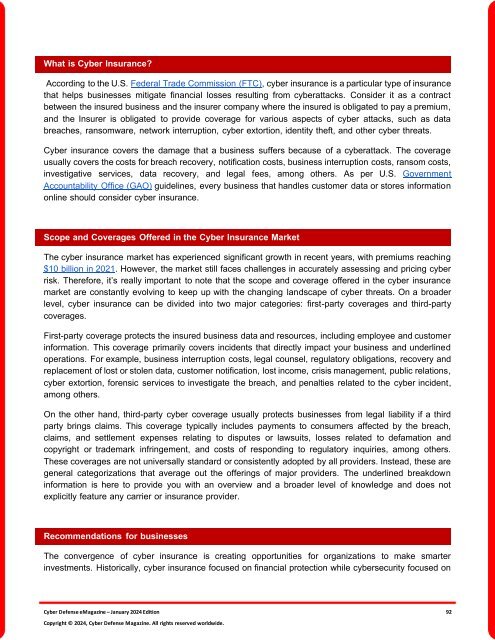The Cyber Defense eMagazine January Edition for 2024
Cyber Defense eMagazine January Edition for 2024 #CDM #CYBERDEFENSEMAG @CyberDefenseMag by @Miliefsky a world-renowned cyber security expert and the Publisher of Cyber Defense Magazine as part of the Cyber Defense Media Group as well as Yan Ross, Editor-in-Chief and many more writers, partners and supporters who make this an awesome publication! 201 page January Edition fully packed with some of our best content. Thank you all and to our readers! OSINT ROCKS! #CDM #CDMG #OSINT #CYBERSECURITY #INFOSEC #BEST #PRACTICES #TIPS #TECHNIQUES
Cyber Defense eMagazine January Edition for 2024 #CDM #CYBERDEFENSEMAG @CyberDefenseMag by @Miliefsky a world-renowned cyber security expert and the Publisher of Cyber Defense Magazine as part of the Cyber Defense Media Group as well as Yan Ross, Editor-in-Chief and many more writers, partners and supporters who make this an awesome publication! 201 page January Edition fully packed with some of our best content. Thank you all and to our readers! OSINT ROCKS! #CDM #CDMG #OSINT #CYBERSECURITY #INFOSEC #BEST #PRACTICES #TIPS #TECHNIQUES
Create successful ePaper yourself
Turn your PDF publications into a flip-book with our unique Google optimized e-Paper software.
What is <strong>Cyber</strong> Insurance?<br />
According to the U.S. Federal Trade Commission (FTC), cyber insurance is a particular type of insurance<br />
that helps businesses mitigate financial losses resulting from cyberattacks. Consider it as a contract<br />
between the insured business and the insurer company where the insured is obligated to pay a premium,<br />
and the Insurer is obligated to provide coverage <strong>for</strong> various aspects of cyber attacks, such as data<br />
breaches, ransomware, network interruption, cyber extortion, identity theft, and other cyber threats.<br />
<strong>Cyber</strong> insurance covers the damage that a business suffers because of a cyberattack. <strong>The</strong> coverage<br />
usually covers the costs <strong>for</strong> breach recovery, notification costs, business interruption costs, ransom costs,<br />
investigative services, data recovery, and legal fees, among others. As per U.S. Government<br />
Accountability Office (GAO) guidelines, every business that handles customer data or stores in<strong>for</strong>mation<br />
online should consider cyber insurance.<br />
Scope and Coverages Offered in the <strong>Cyber</strong> Insurance Market<br />
<strong>The</strong> cyber insurance market has experienced significant growth in recent years, with premiums reaching<br />
$10 billion in 2021. However, the market still faces challenges in accurately assessing and pricing cyber<br />
risk. <strong>The</strong>re<strong>for</strong>e, it’s really important to note that the scope and coverage offered in the cyber insurance<br />
market are constantly evolving to keep up with the changing landscape of cyber threats. On a broader<br />
level, cyber insurance can be divided into two major categories: first-party coverages and third-party<br />
coverages.<br />
First-party coverage protects the insured business data and resources, including employee and customer<br />
in<strong>for</strong>mation. This coverage primarily covers incidents that directly impact your business and underlined<br />
operations. For example, business interruption costs, legal counsel, regulatory obligations, recovery and<br />
replacement of lost or stolen data, customer notification, lost income, crisis management, public relations,<br />
cyber extortion, <strong>for</strong>ensic services to investigate the breach, and penalties related to the cyber incident,<br />
among others.<br />
On the other hand, third-party cyber coverage usually protects businesses from legal liability if a third<br />
party brings claims. This coverage typically includes payments to consumers affected by the breach,<br />
claims, and settlement expenses relating to disputes or lawsuits, losses related to defamation and<br />
copyright or trademark infringement, and costs of responding to regulatory inquiries, among others.<br />
<strong>The</strong>se coverages are not universally standard or consistently adopted by all providers. Instead, these are<br />
general categorizations that average out the offerings of major providers. <strong>The</strong> underlined breakdown<br />
in<strong>for</strong>mation is here to provide you with an overview and a broader level of knowledge and does not<br />
explicitly feature any carrier or insurance provider.<br />
Recommendations <strong>for</strong> businesses<br />
<strong>The</strong> convergence of cyber insurance is creating opportunities <strong>for</strong> organizations to make smarter<br />
investments. Historically, cyber insurance focused on financial protection while cybersecurity focused on<br />
<strong>Cyber</strong> <strong>Defense</strong> <strong>eMagazine</strong> – <strong>January</strong> <strong>2024</strong> <strong>Edition</strong> 92<br />
Copyright © <strong>2024</strong>, <strong>Cyber</strong> <strong>Defense</strong> Magazine. All rights reserved worldwide.

















